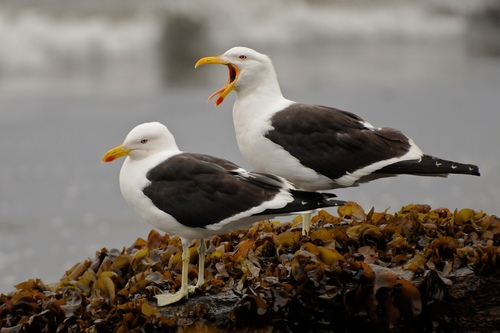
Kelp Gull
The Kelp Gull (*Larus dominicanus*) is a large, widespread gull species found throughout the Southern Hemisphere. It plays a significant ecological role as both a predator and scavenger in coastal environments. Known for its adaptability, the Kelp Gull thrives in diverse habitats, from rocky coastlines and sandy beaches to urban areas. While not possessing any specific widespread cultural significance, its ubiquity makes it a familiar sight in many southern coastal communities and it is sometimes referred to as the 'Dominican Gull'.
52-64 cm
Length
128-142 cm
Wingspan
Least Concern
Conservation Status
Distribution
Found in South America, Southern Africa, Australia, New Zealand, and many sub-Antarctic islands. It is a largely non-migratory species, though some populations may undertake local movements in response to food availability.
Lifespan
Up to 25 years in the wild, though the average lifespan is likely shorter.
Kelp Gull's Habitat
Habitat Types
Coastal areas, Estuaries, Rocky shores, Sandy beaches, Offshore islands, Urban environments (near the coast)
Climate Zones
Temperate, Subtropical, Subantarctic
Adaptations
Kelp Gulls are highly adaptable to various coastal habitats. They are strong fliers and swimmers, capable of foraging in both marine and terrestrial environments. Their broad diet allows them to exploit a wide range of food sources.
Variations
Five subspecies are generally recognized, differing slightly in size and mantle coloration: *L. d. dominicanus*, *L. d. vetula*, *L. d. judithae*, *L. d. melisandae*, and *L. d. austrinus*.
Appearance
Breeding Plumage
Adults have a white head, neck, and underparts, with a black back and wings. The non-breeding plumage is similar, but the head may be streaked with brown.
Seasonal Feather Changes
Minor seasonal variations, mainly in head streaking.
Sex Based Plumage Differences
Minimal sexual dimorphism in plumage; males and females are very similar.
Notable Features
Yellow bill with a red spot on the lower mandible, Yellowish-green legs, Dark eyes, White tail with a black subterminal band
Diet and Feeding
Primary Foods
Fish, Mollusks, Crustaceans, Insects, Carrion, Eggs and chicks of other birds, Human refuse
Foraging Behavior
Kelp Gulls are opportunistic feeders, employing various foraging techniques. They may scavenge along the shoreline, plunge-dive for fish, or steal food from other birds (kleptoparasitism). They also drop hard-shelled prey from a height to break them open.
Specializations
Their strong bill allows them to handle a wide variety of prey items. They are also adept at exploiting human-generated food sources.
Seasonal Diet Variations
Diet may shift depending on the availability of prey. For example, they may consume more fish during certain seasons or rely more on carrion during breeding periods of other seabirds.
Behavior
Social Structure
Kelp Gulls are often found in flocks, especially outside the breeding season. They can be highly social when foraging or roosting.
Communication
Loud, raucous calls, Head-tossing displays, Bowing displays
Migration
Generally non-migratory, although some populations may undertake local movements in response to food availability or breeding opportunities.
Territorial or Group Behaviors
During the breeding season, Kelp Gulls are highly territorial, defending their nesting sites from intruders. They often nest in colonies.
Conservation
Threats
Habitat destruction, Human disturbance at breeding colonies, Pollution (e.g., oil spills, plastic ingestion), Entanglement in fishing gear
Protection Programs
Protection of breeding colonies, Monitoring of populations
Local National Laws
Protected under various national and international wildlife conservation laws, though specific regulations vary by country.
Population Trend
Stable
Population Estimates
The global population is estimated to be in the millions.
Interesting Facts
Kelp Gulls are known to use tools.
They drop shellfish onto hard surfaces to break them open, a behavior demonstrating their intelligence.
They are highly adaptable to urban environments.
They have learned to exploit human-generated food sources, such as landfills and fishing discards.
They are opportunistic predators.
They will prey on the eggs and chicks of other seabirds, including penguins.
Faqs about Kelp Gull
Are Kelp Gulls aggressive?
Kelp Gulls can be aggressive, especially when defending their nests or young. They may swoop at perceived threats.
What do Kelp Gull chicks look like?
Kelp Gull chicks are covered in downy, mottled brown and grey feathers, providing camouflage.
How can I distinguish a Kelp Gull from other gull species?
The Kelp Gull's large size, black back, yellow bill with a red spot, and yellowish-green legs are key identifying features. Compare its size and plumage with other gulls in your region.
Copyright @ Nature Style Limited. All Rights Reserved.
 English
English